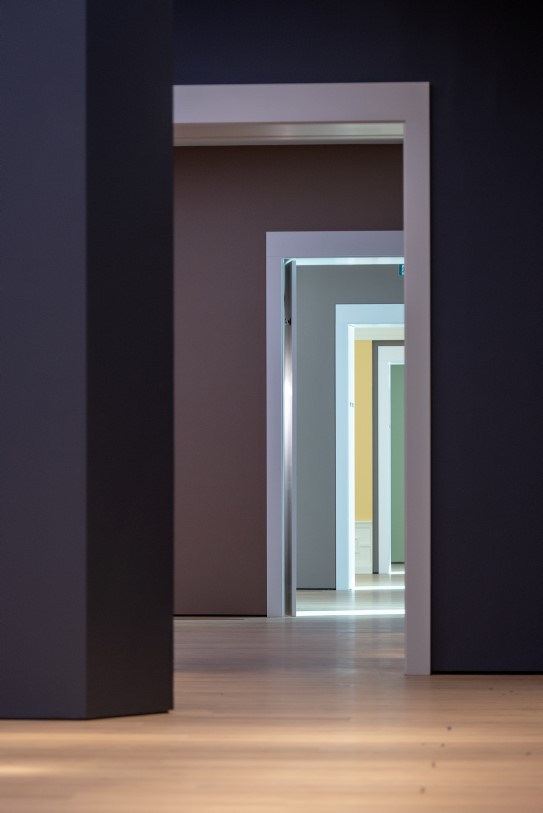Rom for utstillinger

Transkripsjon
Forteller:
Korleis bygge eit nasjonalmuseum som både er klassisk og moderne - med rom som stadig kan endrast og tilpassast nye krav og teknologiar – og som kan hjelpe publikum til betre å sjå sine nasjonale skattar – sin kunst?
Å bygge eit nytt museum startar med det som skal vere inni bygningen.
I arkitektkonkurransen som blei lyst ut, gav Nasjonalmuseet mange retningslinjer.
Det grunnleggjande spørsmålet var: Korleis kan ein vise fram alt frå 3000 – 5000 kunstverk og gjenstandar frå, ulike tider og kunstdisplinar – i eitt og samme bygg?
Det var behov for store salar, mindre rom, fleksible areal som kunne tilpassast ulike utstillingar, intime rom for små objekt, og store soner for monumentale kunstverk. Det måtte vera soner som publikum kunne kvile i, og eit flettverk av mulige utstillingsruter for besøkjande med ulike interesser og ønske.
Når dei arkitektoniske rammene var klare og kuratorane begynte å få oversikt over kva som skulle stillast ut, kom utstillingsdesignarane og interiørarkitektane inn i biletet.
Det byr på fleire utfordringar når ein byggjer eit nytt museum der ingen har arbeidd før og alt skal skje for fyrste gong.
Marco Magni:
It’s very rare that somebody makes a national museum like this all together, from, let´s say nothing. So it was very important to share the process.
Forteller:
Dette er Marco Magni, grunnleggjar av det italienske arkitektfirmaet Guicciardini & Magni, som har spesialisert seg på utstillingsdesign. Dei vann det største utstillingsoppdraget i Norge nokonsinne.
For å hjelpe til med planlegginga og utstillingane til det nye bygget, var det nødvendig for Marco og teamet hans å lage skisser med mål av kvar gjenstand som museet ønsket å vise fram.
Slik kunne dei få oversikt over proporsjoner og dimensjonar - og over volumet av gjenstander og kunstverk. Tusenvis av skisser seinare kunne utstillingsarkitektene og dei tilsette ved museet begynne å planlegge fysiske utstillingar i tråd med arkitekturen i bygget.
Cristina Rizzello:
Every decision we made, we made together with people that work at the museum. At any level from conservator to technicians.
Forteller:
Utstillingsarkitekt Cristina Rizzello flytta permanent til Oslo for å fylgja heile prosessen og for å studere den norske identiteten.
Cristina Rizzello:
Yes, it´s essential for us to us to study and to try to understand what’s the purpose, because we are talking about a national museum, so in a way it’s the story of a nation.
Forteller:
Å designe eit utstillingsrom er nesten som å fortelje ei historie – kva som er starten, midten og slutten er viktig.
Cristina Rizzello:
The way to approach to design, it’s for us a way to translate the meaning of the objects, of the art works, and convey the story that the curators want to express in a particular room or for a particular object. And we try to translate it into something visual, like an exhibition display.
Forteller:
Nasjonalmuseet i Vika har utstillingar over tre etasjar.
Samlingsutstillingane i første og andre etasje er bygd opp kronologisk. Første etasje er i hovudsak design og kunsthåndverk, og andre etasje er primært fylt med maleri, skulptur og utstillingar om arkitektur.
Dette krevde heilt ulik tilnærming frå ustillingsarkitektane:
Cristina Rizzello:
At the first floor you will find objects within cases, display cases, so most of the collection is protected in very beautiful and also very complex machines. In the second floor you will find mostly paintings and no glass – so the visit will be different.
Forteller:
Den kanskje største utfordringa med eit så stort museum er at det er mykje å ta inn for deg som er på besøk. Kor skal du starte, kva vil du sjå? Dette er noko Marco Magni og teamet hans har jobba mykje med:
Marco Magni:
We tried to create a rhythm where we have higher moments and lower moments, which are balanced, and we tried to avoid boredom, creating a great variation of specific installations based on the artworks and objects. So, for example, we introduced an important use of colors to distinguish the rooms, the sections that we have, and also many different shapes and spesific installations.
Forteller:
Eit viktig element i samlingsutstillingane er digitale element som film, lyd og foto, som utvidar opplevelsen for publikum:
Cristina Rizzello:
Since it’s a long journey and we hope that people can come many times to enjoy the museum, not only once, then you will find every time a new thing to do.
Like the fairy tale room, you will find a tree, you will hear the voice of animals – there are many different surprises. And you will find incredible artworks.